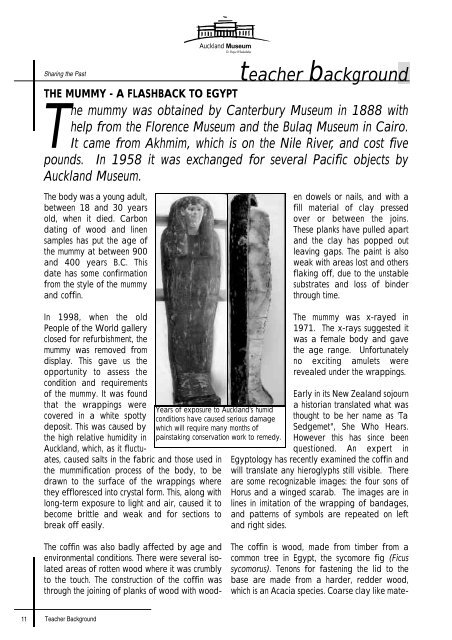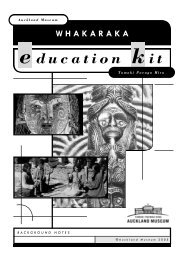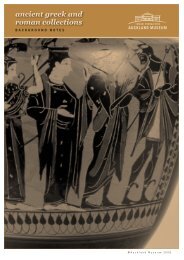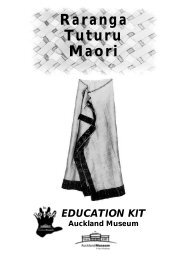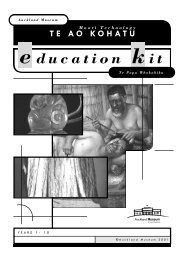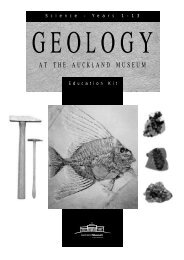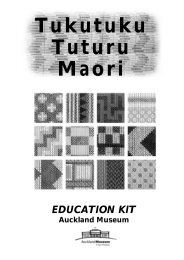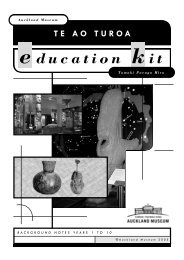Create successful ePaper yourself
Turn your PDF publications into a flip-book with our unique Google optimized e-Paper software.
Sharing <strong>the</strong> Past<br />
The body was a young adult,<br />
between 18 and 30 years<br />
old, when it died. Carbon<br />
dating of wood and linen<br />
samples has put <strong>the</strong> age of<br />
<strong>the</strong> mummy at between 900<br />
and 400 years B.C. This<br />
date has some confirmation<br />
from <strong>the</strong> style of <strong>the</strong> mummy<br />
and coffin.<br />
In 1998, when <strong>the</strong> old<br />
People of <strong>the</strong> World gallery<br />
closed for refurbishment, <strong>the</strong><br />
mummy was removed from<br />
display. This gave us <strong>the</strong><br />
opportunity to assess <strong>the</strong><br />
condition and requirements<br />
of <strong>the</strong> mummy. It was found<br />
that <strong>the</strong> wrappings were<br />
covered in a white spotty<br />
deposit. This was caused by<br />
<strong>the</strong> high relative humidity in<br />
<strong>Auckland</strong>, which, as it fluctuates,<br />
caused salts in <strong>the</strong> fabric and those used in<br />
<strong>the</strong> mummification process of <strong>the</strong> body, to be<br />
drawn to <strong>the</strong> surface of <strong>the</strong> wrappings where<br />
<strong>the</strong>y effloresced into crystal form. This, along with<br />
long-term exposure to light and air, caused it to<br />
become brittle and weak and for sections to<br />
break off easily.<br />
The coffin was also badly affected by age and<br />
environmental conditions. There were several isolated<br />
areas of rotten wood where it was crumbly<br />
to <strong>the</strong> touch. The construction of <strong>the</strong> coffin was<br />
through <strong>the</strong> joining of planks of wood with wood-<br />
11 Teacher Background<br />
<strong>Auckland</strong> <strong>Museum</strong><br />
Te Papa Whakahiku<br />
THE MUMMY - A FLASHBACK TO EGYPT<br />
The mummy was obtained by Canterbury <strong>Museum</strong> in 1888 with<br />
help from <strong>the</strong> Florence <strong>Museum</strong> and <strong>the</strong> Bulaq <strong>Museum</strong> in Cairo.<br />
It came from Akhmim, which is on <strong>the</strong> Nile River, and cost five<br />
pounds. In 1958 it was exchanged for several Pacific objects by<br />
<strong>Auckland</strong> <strong>Museum</strong>.<br />
Years of exposure to <strong>Auckland</strong>'s humid<br />
conditions have caused serious damage<br />
which will require many months of<br />
painstaking conservation work to remedy.<br />
teacher background<br />
en dowels or nails, and with a<br />
fill material of clay pressed<br />
over or between <strong>the</strong> joins.<br />
These planks have pulled apart<br />
and <strong>the</strong> clay has popped out<br />
leaving gaps. The paint is also<br />
weak with areas lost and o<strong>the</strong>rs<br />
flaking off, due to <strong>the</strong> unstable<br />
substrates and loss of binder<br />
through time.<br />
The mummy was x-rayed in<br />
1971. The x-rays suggested it<br />
was a female body and gave<br />
<strong>the</strong> age range. Unfortunately<br />
no exciting amulets were<br />
revealed under <strong>the</strong> wrappings.<br />
Early in its New Zealand sojourn<br />
a historian translated what was<br />
thought to be her name as 'Ta<br />
Sedgemet", She Who Hears.<br />
However this has since been<br />
questioned. An expert in<br />
Egyptology has recently examined <strong>the</strong> coffin and<br />
will translate any hieroglyphs still visible. There<br />
are some recognizable images: <strong>the</strong> four sons of<br />
Horus and a winged scarab. The images are in<br />
lines in imitation of <strong>the</strong> wrapping of bandages,<br />
and patterns of symbols are repeated on left<br />
and right sides.<br />
The coffin is wood, made from timber from a<br />
common tree in Egypt, <strong>the</strong> sycomore fig (Ficus<br />
sycomorus). Tenons for fastening <strong>the</strong> lid to <strong>the</strong><br />
base are made from a harder, redder wood,<br />
which is an Acacia species. Coarse clay like mate-


